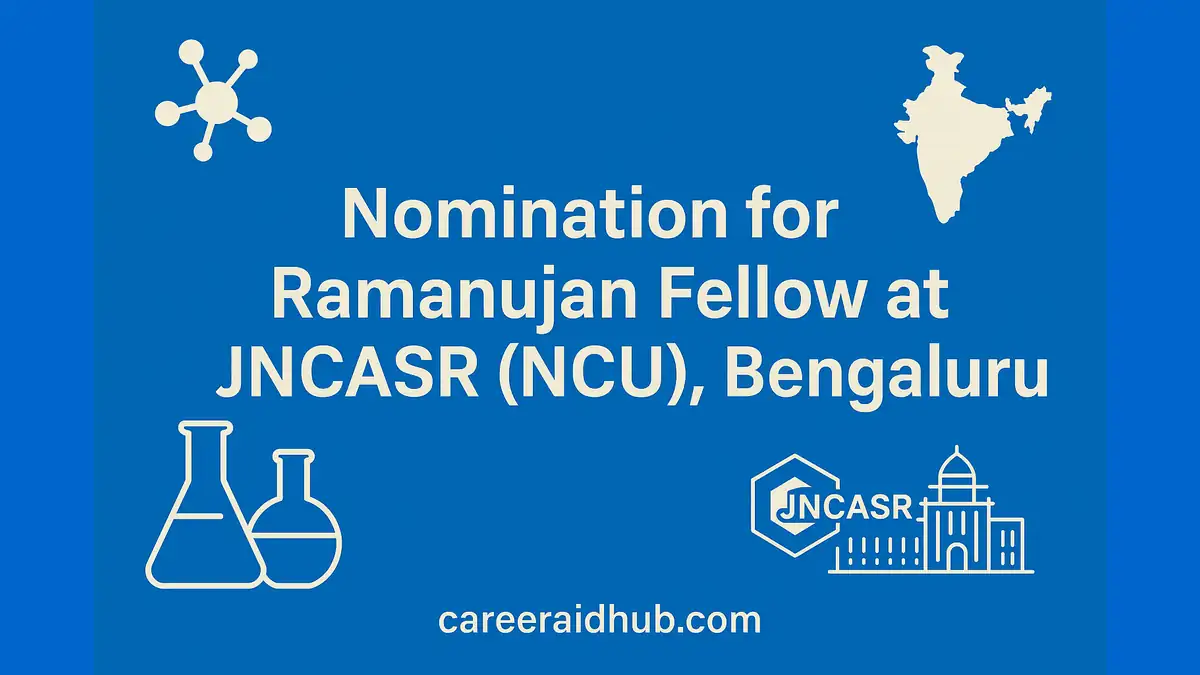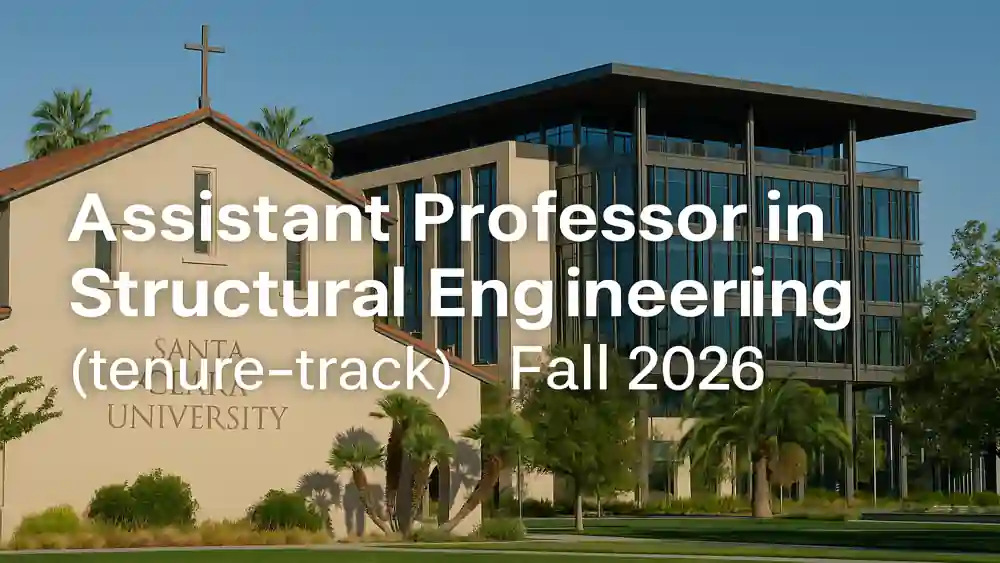Nomination for Ramanujan Fellow at JNCASR (NCU), Bengaluru — Chemistry Focus
India’s research ecosystem is expanding rapidly, and the Ramanujan Fellowship offers a decisive pathway for outstanding Indian and Indian-origin scientists abroad to return and lead independent programs. Through this call, the New Chemistry Unit (NCU) at the Jawaharlal Nehru Centre for Advanced Scientific Research (JNCASR), Bengaluru invites nominations from chemists with a demonstrable record of excellence and a clear vision for frontier work. Unlike traditional hires, this is a fellowship-backed appointment hosted by JNCASR. Consequently, the Centre provides essential administrative support and access to core research infrastructure, while the fellow sets the scientific agenda, mentors postgraduate and doctoral researchers in co-supervision with unit faculty, and contributes to advanced teaching and outreach. The model empowers early-career leaders to assemble a small team, compete for extramural grants, and produce visible outputs over a focused five-year horizon.
For complete institutional details—including scope, expectations, and submission instructions—please consult the official JNCASR advertisement for the New Chemistry Unit’s Nomination for Ramanujan Fellow.
Launch an independent research program in India’s premier science ecosystem. JNCASR’s New Chemistry Unit invites nominations
for the Ramanujan Fellowship—ideal for high-potential chemists abroad seeking a five-year, well-funded platform to build a visible research group, mentor scholars, and compete for major grants in a collaborative, high-impact environment.
Priority Target: September 2025 (recommended) • Official Window: Rolling submissions through 2025
Because timing is critical, candidates are encouraged to plan toward a September 2025 submission target (recommended) to accommodate internal shortlisting, seminar interactions, and host endorsement before routing the file through the national portal. Looking ahead, the subsequent cycle is expected around August–September 2026—we will update soon. With thoughtful preparation, applicants can align proposal milestones, facility needs, and first-year teaching commitments to ensure a strong start.
If you’re an outstanding early-career Indian or Indian-origin scientist working abroad and aiming to establish an independent research program in India, the Ramanujan Fellowship remains one of the strongest entry routes. The Jawaharlal Nehru Centre for Advanced Scientific Research (JNCASR) in Bengaluru invites nominations for Ramanujan Fellow in the New Chemistry Unit (NCU). The Centre provides administrative support and essential R&D infrastructure to selected fellows. Because this is a fellowship-backed appointment, JNCASR has no obligation to offer a regular position; nevertheless, the platform often serves as a powerful springboard for forming a lab, supervising students, and competing for larger grants.
Why this call matters
A strategic pathway for independence
style="text-align: justify;">This call targets
high-calibre chemists ready to lead a focused,
independent research program from day one. JNCASR’s culture emphasizes rigor and originality, enabling fellows to position their work at the
frontiers of chemical science—from molecular design and catalysis to energy materials and chemical biology.
Training, mentoring, and visibility
Fellows are expected to co-mentor Master’s and Ph.D. students with regular faculty, contribute to teaching and outreach, and cultivate collaborations within a vibrant research ecosystem. By combining mentorship with cutting-edge projects, you build an early record of leadership, team development, and measurable impact—often the key to future faculty appointments.
About the Ramanujan Fellowship (National Program)
Purpose and audience
The Ramanujan Fellowship—administered on the ANRF portal—seeks to attract brilliant Indian/Indian-origin scientists working abroad, typically under 40 years of age, to undertake five-year, non-extendable research appointments in India. The host institution provides basic lab and administrative support, while the national fellowship supplies the consolidated monthly stipend, annual research grant, and overheads to the host.
What the support looks like
At present norms, the package comprises a ₹1,35,000 per month consolidated fellowship (including HRA), an annual research grant of ₹7.00 lakh, and ₹60,000 per year in overheads to the host. The scheme also permits fellows to apply for other competitive grants during tenure, enabling a layered funding strategy
with external agencies and industry partners.
Who should apply to JNCASR–NCU?
Fit with NCU research priorities
-
-
Field: Advanced areas across Chemistry. Projects that either complement current NCU programs or introduce novel capability are encouraged.
-
Profile: A completed Ph.D., ≥2 years of postdoctoral experience, high-quality publications, and a coherent, forward-looking research vision suited to NCU’s facilities and collaborative networks.
National-scheme eligibility (at nomination)
-
-
Usually <40 years.
-
Working abroad when nominated.
-
Demonstrated research excellence with a trajectory toward independence.
-
No current position in India at the time of nomination under the prevailing norms.
Role & expectations at NCU
Lead, mentor, engage
-
-
Independent research leadership: Define a clear scientific agenda and a feasible execution plan.
-
Student development: Co-supervise Master’s and Ph.D. researchers alongside NCU faculty, ensuring structured milestones and timely outputs.
-
Teaching & outreach: Offer advanced topics or lab-intensive modules aligned with your expertise; participate in seminars and community programs.
Funding & collaboration: Pursue extramural grants and inter-disciplinary linkages to expand capability and visibility.
Note: This pathway is explicitly fellowship-backed. JNCASR does not have an obligation to convert the fellowship into a regular appointment. Many fellows, however, leverage this period to build a compelling case for long-term roles within India’s premier institutions.
Application package (to JNCASR–NCU)
Compile a single, well-structured PDF
Email one combined PDF to the Chair, NCU at [email protected]. Include:
-
-
Curriculum Vitae (CV) with full publications and highlights.
-
Completed fellowship application (or, if the ANRF call window is not yet open, a substantive future research statement articulating objectives, methods, facilities required, and a 24–60-month workplan).
-
Three most significant publications (PDFs), each accompanied by a brief note on novelty, citations/usage, and potential for follow-on work.
-
Teaching statement listing advanced courses, tutorials, or laboratory modules you can deliver immediately.
-
Contact information for at least three referees (names, positions, institutional email).
What happens next: Applications are accepted year-round. Shortlisting typically involves expert panel review and seminars/interactions with NCU faculty. If selected, the Unit issues a host endorsement/sponsorship required for the national portal submission.
Tip for applicants: Treat the PDF as a mini-dossier. Use clear headings, numbered sections, and a one-page executive summary so panels can grasp your value proposition quickly.
How the national nomination works (quick overview)
Steps on the ANRF portal
Once you secure JNCASR–NCU endorsement, proceed to the ANRF online portal to:
-
-
Register and access the Ramanujan Fellowship application.
-
Upload your proposal (commonly ~5 pages), CV, and required documents in the exact formats requested.
-
Route the application to the host-institution nominator for online submission.
-
Await periodic national-level evaluation by an empowered committee.
Pro-tip: Mirror your NCU proposal with the national application, but adapt to the portal’s format and evaluation criteria. Keep impact, feasibility, and national relevance at the forefront.
Timeline & planning your submission
Recommended planning horizon
-
-
Priority target: September 2025. Working toward this month gives enough time for internal shortlisting, seminar interactions, endorsement, and a polished national submission—without compressing critical steps.
-
Official window: The opportunity is listed for rolling submissions through 2025. Planning ahead helps you avoid year-end bottlenecks and holiday slowdowns.
Dates for the next cycle (indicative)
-
-
Based on typical national fellowship rhythms, expect the next cycle to concentrate around August–September 2026—we will update soon. This estimate helps international applicants time resignations, visas, and relocations sensibly.
Publisher notes (SEO & updates)
-
-
Ensure the page is indexable (no noindex flags).
-
Review quarterly and refresh in September and January with any changes in eligibility, grant ceilings, or portal workflows.
Selection signals: what will strengthen your case
Craft a persuasive scientific narrative
-
-
Frontier-level agenda: Articulate the problem landscape, state-of-the-art, and your differentiator. Show feasibility with an equipment, methods, and staffing plan aligned to NCU labs.
-
Independence & identity: Flag senior-author papers, independent ideas, and how your work diverges from your Ph.D./postdoc labs.
Demonstrate strategic fit and readiness
-
-
NCU synergy: Map concrete interfaces (shared instrumentation, complementary expertise, potential co-advised projects).
-
Teaching readiness: Provide a menu of course titles, mini-syllabi, and assessment styles you can deliver in the first year.
Suggested internal reading: Explore related opportunities on CareerAidHub (e.g., the Kellogg Institute Visiting Fellowship guide on our site) to benchmark statements of purpose and teaching dossiers for competitive programs.
How to apply (action checklist)
-
-
Study NCU’s research areas and identify direct points of contact (facilities, methods, collaborations) that increase feasibility.
-
Prepare the JNCASR package—CV, three key papers with short impact notes, teaching statement, referees, and a research plan if the ANRF window is not yet open. Email one PDF to [email protected].
-
If shortlisted, present your seminar, refine your fit based on faculty feedback, and finalize resource needs.
-
After endorsement, complete your ANRF portal submission precisely as instructed (formats, file sizes, and required certifications).
Practical tip: Maintain a two-column table mapping portal fields to your dossier sections so nothing is missed during uploads or routing.
Final word
For rising chemists abroad who are prepared to lead from day one, this call offers a rare opportunity: five years of concentrated support inside an elite Indian research centre to build a group, train scholars, and demonstrate competitive funding success. Target September 2025 for your NCU package, then convert that momentum into a strong national nomination.
Program Snapshot (Feature Details)
| Feature |
Details |
| Program Name |
Ramanujan Fellowship — Nomination via JNCASR (New Chemistry Unit) |
| Host Country |
India |
| Funded By |
ANRF (national fellowship scheme) with JNCASR as host |
| Duration |
Five years (non-extendable) |
| Study Mode |
Full-time, on-site at host institution |
| Eligibility |
Indian/Indian-origin scientists typically <40 years, working abroad at nomination, strong publication record |
| Financial Support |
₹1,35,000 per month (consolidated); ₹7.00 lakh/yr research grant; ₹60,000/yr host overheads |
| Fields of Study |
Chemistry (frontier areas) within NCU’s scope |
| Deadline |
September 2025 — we will update soon |
| Official Website |
Official citation: JNCASR announcement PDF |
Official citation: ANRF scheme page
Frequently Asked Questions
What is the Ramanujan Fellowship at JNCASR NCU for chemists? The fellowship enables outstanding chemists to lead an independent program at JNCASR’s New Chemistry Unit, with host support and national funding, while building publications, mentoring students, and securing external grants.
Who is eligible for Ramanujan Fellowship nominations at JNCASR NCU? Typically, Indian or Indian-origin scientists with a Ph.D., strong publications, about two years’ postdoc experience, and a clear research plan qualify; moreover, they should be working abroad at nomination.
What is the age limit for the Ramanujan Fellowship nomination? The scheme generally targets candidates below 40 at nomination; however, review official guidelines for any permissible relaxations or updates before preparing your dossier and timeline.
Does the Ramanujan Fellowship provide a regular faculty position at JNCASR? No. The fellowship backs an independent appointment hosted by JNCASR; however, strong performance can later support competitive applications to regular faculty tracks at Indian institutions.
What funding does the Ramanujan Fellowship offer to selected fellows? It typically includes a consolidated monthly fellowship, an annual research grant for consumables and minor equipment, and host overheads; furthermore, fellows may apply for additional competitive grants.
Which documents should I include in the JNCASR NCU application package? Include a CV, fellowship form or research statement, three key publications with impact notes, a teaching statement, and at least three referees; additionally, provide a concise executive summary.
What is the duration of the Ramanujan Fellowship appointment in India? The fellowship runs for five years and is non-extendable; therefore, plan deliverables, equipment needs, hiring, and milestones across the full term to demonstrate sustained impact.
Can Ramanujan Fellows apply for additional research grants while at JNCASR? Yes. Fellows can pursue external competitive grants; moreover, aligning proposals with national priorities and JNCASR facilities strengthens feasibility, visibility, and long-term funding prospects.
When should I submit my JNCASR NCU nomination for the Ramanujan Fellowship? Aim for a September submission to avoid year-end bottlenecks. Subsequently, expect the next cycle around August–September the following year; plan seminars, endorsements, and portal steps accordingly.
Premium Mentorship for a Stronger Application
- Premium Mentorship: personalised 1:1 guidance for this and similar opportunities
- In-depth review of your CV, academic profile, and key statements
- Aligned with international selection criteria so your profile matches what panels expect
- Stronger, more compelling narrative for highly competitive calls
- Step-by-step support from opportunity mapping to final submission (fee-based)
Subscribe Premium Mentorship










